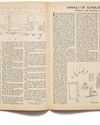
The National Monument to Freedom, in Montgomery, Alabama, is a giant book, standing forty-three feet high and a hundred and fifty feet wide. The book is propped wide open, and engraved on its surface are the names of more than a hundred and twenty thousand Black people, documented in the 1870 census, who were emancipated after the Civil War. On the spine of the book is a credo written for the dead:
Your children love you.
The country you built must honor you.
We acknowledge the tragedy of your enslavement.
We commit to advancing freedom in your name.
The history of slavery is one of elisions and silences, of moving on. The civil-rights attorney Bryan Stevenson, who designed the monument, has taken a different approach, displaying the realities of enslavement on a monumental scale. His colossal book is the centerpiece of the Freedom Monument Sculpture Park, which opens in late March. Set on a high bluff overlooking the Alabama River, the park presents a painstaking narrative history of slavery, using first-person recollections, historical artifacts, and more than fifty sculptures. The park is the third site in Montgomery created in recent years by Stevenson and his legal nonprofit, the Equal Justice Initiative.
Denne historien er fra April 01, 2024-utgaven av The New Yorker.
Start din 7-dagers gratis prøveperiode på Magzter GOLD for å få tilgang til tusenvis av utvalgte premiumhistorier og 9000+ magasiner og aviser.
Allerede abonnent ? Logg på
Denne historien er fra April 01, 2024-utgaven av The New Yorker.
Start din 7-dagers gratis prøveperiode på Magzter GOLD for å få tilgang til tusenvis av utvalgte premiumhistorier og 9000+ magasiner og aviser.
Allerede abonnent? Logg på

SUBJECT AND OBJECT
What happened when Lillian Ross profiled Ernest Hemingway.

ROYAL FLUSH
The fall of red.

Roz Chast on George Booth's Cartoons
There's almost nothing I like more than a laughing fit. It is a non-brain response, like an orgasm or a sneeze.

CHUKA
I have always longed to be known, truly known, by another human being. Sometimes we live for years with yearnings that we cannot name.

Rachel Aviv on Janet Malcolm's "Trouble in the Archives"
As Janet Malcolm worked on \"Trouble in the Archives,\" a two-part piece about prominent psychoanalysts who disagreed about Freud, she began a correspondence with Kurt Eissler, the head of the Sigmund Freud Archives.

PERSONAL HISTORY - A VISIT TO MADAM BEDI
I was estranged from my own mother, so a friend tried to lend me his.

AMERICAN CHRONICLES - WAR OF WORDS
Editors, writers, and the making of a magazine.

LIVE FROM NEW YORK
A new docuseries commemorates fifty years of \"Saturday Night Live.\"

TANGLED WEB
An arachnophobe pays homage to the spider.

TROUBLE IN PARADISE
Mike White's mischievous morality plays.